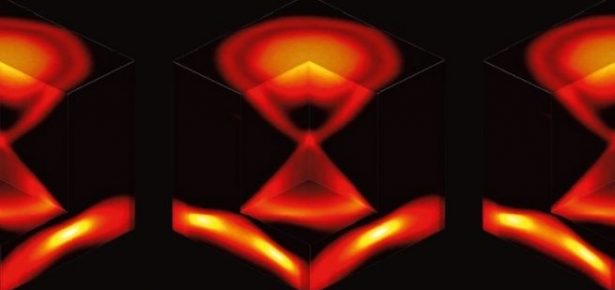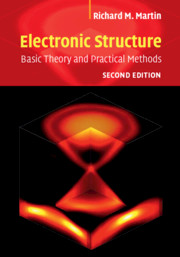
Richard M. Martin, author of Electronic Structure: Basic Theory and Practical Methods’, Second Edition, (2020) gives his personal reasons for updating the original edition (2004)
Why would anyone write a new edition of a book that is still selling after many years? The explanations of the basic theory in the first edition are still valid, and the methods are still the ones that are most widely used. However I still felt an update was required.
Reason #1: Topology.
The initial reason for writing a new edition is the major development in the field of electronic structure that was completely unknown in 2004 when the first edition was published. The advent of topology as a part of theory of electrons in crystals is not only a revolution in the fundamental theory but also a revolution in experimental phenomena and potential devices. The meaning of “electronic structure” has expanded. Topology is now part of the field that every theorist should know.
So what is needed beyond the many papers and review articles and excellent books like the one by David Vanderbilt[i]? To my knowledge there is no pedagogical presentation of the theory in a way that the elegant topological arguments are combined with basic theory of electronic structure along with practical methods for computation and applications.
“at its heart electronic structure is the theory of interacting electrons”
There is a need for a book that starts with the idea that “at its heart electronic structure is the theory of interacting electrons”, provides in-depth explanations of the general theory and DFT, and describes the most widely-used methods along with examples. Today such a book should also include the theory and consequences of the topology of the electronic structure. Already in the first edition there are precedents for the new developments that are some of my favorite topics. Most notable is the theory of electric polarization in terms of Berry phases of the complex wave functions in a crystal. The Thouless ‘electron pump’ is described in the first edition as an easy-to-understand cyclical variation of the Hamiltonian that transports integer numbers electrons through an insulator. In the new edition, this is recognized as a topological property, and it provides an easy-to-understand step toward topological insulators
My goal was to present the theory in a way that the topological properties can be understood using only the superposition principle of quantum mechanics, band theory at the level of a first year course in solid state physics, and the effects of spin-orbit interaction at the simplest possible level. Berry phases can be understood within a few pages and topological Chern numbers follow with only a small amount of guidance. Of course, topology is a vast topic far beyond the explanations I present in this book, but it is amazing how quickly the relevant aspects can be appreciated. Similarly it is amazing how the properties can be described using only two-band tight-binding models. Furthermore, my approach brings out the physics most clearly starting with a three-band model (s, px, py) where is easy to include spin-orbit interactions.
Even though the topology of the electronic states is a bulk effect, the observable consequences are surface states. Surface states are an old topic that is already a part of the original edition. They are now of increased importance and this should be reflected in the treatment of the theory and calculation methods for surface states, clearly identifying the new aspects of surface states required by topology. Spin-orbit interaction is an essential ingredient for topological insulators; even though it has long been an important part of electronic structure, now it is even more important and should be treated in more depth.
In addition, it is edifying to place all the developments in pedagogical and historical perspective. This includes derivation of Berry phase that is more pedagogical than in the first edition, Dirac’s derivation of spin-orbit interaction, Tamm and Shockley surface states, relation to the quantum Hall effect, and the way that the topological arguments finally provide the answer to the decades old question of when it is possible to construct localized Wannier functions and when it is not possible.
Reason #2: Advances in the field.
Electronic structure has grown enormously in the depth of the theory and the impact on almost every field of science and technology. The subtitle of the book is “basic theory and practical methods” which describes my motivation.
Although the fundamentals of DFT have not changed, there have been great improvements in functionals and realizations of time-dependent DFT in solids. The major developments of functionals of the wave functions follow the path outlined in the first edition; however, they have gone much beyond what was envisioned at that time. Band gaps can now be predicted with remarkable accuracy using hybrid functionals, which can also describe excitons in time-dependent DFT. New theoretical developments have led to successful Van der Waals functionals. In the new edition the description of functionals is expanded to two chapters to cover the basic theory and practical applications, as well as additional material to explain the theory and methods for time-dependent DFT in condensed matter.
Reason #3: The companion book ‘Interacting Electrons’ (Cambridge University Press, 2016).
The goal when the first book was started in 1995 was to present electronic structure as one of the most challenging interacting many-body problems in physics, as well as one of the most useful and important endeavors in theoretical physics. It was deeply rewarding to work with Lucia Reining and David Ceperley, to write the book ‘Interacting Electrons: Theory and Computational Approaches’, which is devoted to the theory and computational methods for explicit many-body approaches. The second edition of the ‘Electronic Structure’ is greatly enhanced by referring to ‘Interacting Electrons’ for in-depth presentation of the many-body theory and consequences for the properties on matter.
A major theme of both books is the use of independent-particle methods to determine properties of the many-body system of interacting electrons. The guiding principles are conservation laws and continuity, which is illustrated perfectly by topology which is classified by integers.
Finally: Something that did not work out.
A goal in writing the second edition was to condense my original arguments and reduce aspects that have proved to be less useful than I initially hoped. With some exceptions, this has failed. In a book that makes efforts to explain the connections among different methods, for example, pseudopotentials and all electron methods, I find that it is very difficult to omit material and still maintain accuracy and coherence. When modifying material written many years ago it is difficult to remember all the connections.
I am pleased with the new material and want to have it published even if it is not everything I wanted the book to be.
In the end I accepted that it is better to have an imperfect new
edition rather than no new edition at all.

Electronic Structure: Basic Theory and Practical Methods, Second Edition
Richard M. Martin (2020)
[i] Berry Phases in Electronic Structure Theory: Electric Polarization, Orbital Magnetization and Topological Insulators, David Vanderbilt, Cambridge University Press, 2018
Latest Comments
Have your say!